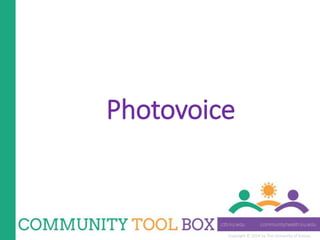
Photovoice
- 1. Copyright © 2014 by The University of Kansas Photovoice
- 2. Copyright © 2014 by The University of Kansas What is photovoice? • Photovoice is a type of participatory action research in which people – usually those with little power – use photographs and/or video to picture their environment and experiences and to express their thoughts about them. • The goals of photovoice: • To provide a voice for those who have none. • To instill critical consciousness. • To influence policy.
- 3. Copyright © 2014 by The University of Kansas Why should you use photovoice? • The rewards of taking photographs are immediate. • Photography is both fun and creative. • Taking photographs or videos of familiar scenes and people can change participants’ perceptions about their social and physical environment. • Basic photography is easy to learn and accessible to almost everyone. • “A picture is worth a thousand words.”
- 4. Copyright © 2014 by The University of Kansas Why should you use photovoice? • Images can be understood regardless of language, culture, or other factors. • Policy makers can’t deny reality when it’s staring them in the face. • Pictures, by creating a clear record of what exists at a particular point in time, can be used to hold policy makers and others accountable. • Photography and video provide a means for empowerment without requiring people to stand up and speak in public.
- 5. Copyright © 2014 by The University of Kansas Who should use photovoice? • People who lack a voice in the community or society, including: • Children and youth in difficult circumstances. • Homeless adults and families. • People with physical and mental disabilities or mental health issues. • People with chronic diseases or medical conditions. • Members of racial, ethnic, language, religious or cultural minorities. • People whose way of life is threatened. • People who are discriminated against because of class, caste, way of life, or poverty. • The rural poor. • People who live in difficult or unacceptable conditions and want to change them.
- 6. Copyright © 2014 by The University of Kansas Who should use photovoice? • Some types of organizations that could benefit by using photovoice with participants: • Schools and other organizations that work with children and youth. • Orphanages, group houses, homeless shelters, and other living situations for those who need care. • Organizations that work with people whose needs and humanity are commonly ignored. • Community health centers and similar health providers. • Organizations that serve people with physical and mental disabilities or mental health issues. • Advocacy organizations or health and human service organizations that include advocacy in their mission. • International aid and refugee organizations.
- 7. Copyright © 2014 by The University of Kansas When might you use photovoice? • When photovoice can change people’s opinions about themselves and their environment. • When a group’s situation needs to be publicized. • When a problem needs to be publicized. • When change is necessary, and photovoice can help sway policy makers. • When a community assessment is needed or in progress. • When you need to document the process of or gather data for an evaluation of an intervention or program. • When you need to hold policy makers or others accountable. • When you need to document a site, an event, or a way of life that is threatened or about to disappear.
- 8. Copyright © 2014 by The University of Kansas How do you use photovoice? • General guidelines: • Photovoice should be a participatory, collaborative process from the beginning. • Participants and staff need training. • Participants need support. • The project should result in some action.
- 9. Copyright © 2014 by The University of Kansas Putting together a photovoice project • Recruit participants, a mentor/facilitator, and staff and/or volunteers. • Plan the project with the community or group you’re working with. Train participants: • Technical training • Training in ethical and safe photography in various situations. • Group-building and training in working in a group.
- 10. Copyright © 2014 by The University of Kansas Putting together a photovoice project • Train staff and/or volunteers: • Technical training. • Group facilitation. • Basic counseling skills. • Structure and aims of the project. • Get out and take pictures. • Work regularly in small groups to discuss and reflect on the experience and the pictures, and to choose each participant’s best photographs or video sequences. • Stage an exhibit of participants’ photographs or videos.
- 11. Copyright © 2014 by The University of Kansas Putting together a photovoice project • Take action. • Follow up. • Evaluate. • Do it again.